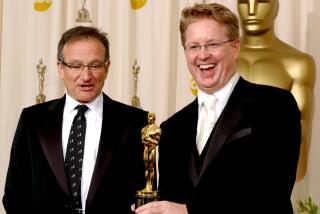From the Archives: ‘Finding Nemo’ Review: Hook, line and sinker
Ahead of the theatrical release of “Finding Dory” Friday, read The Times’ original review of “Finding Nemo,” which opened in theaters May 30, 2003.
We’ve suspected it for some time, but “Finding Nemo” all but makes it official: With five successes out of five attempts, Pixar Animation Studios is now the most reliable creative force in Hollywood. Perhaps not since Preston Sturges made seven classic comedies in a row between 1940 and 1944 has one name been such a consistent indicator of audience and critical pleasure.
Following the two “Toy Story” films, “A Bug’s Life” and “Monsters, Inc.,” Pixar’s entertainment philosophy gets another boost with “Finding Nemo,” an engaging undersea story, written and directed by Andrew Stanton, of a fish family learning life lessons that (surprise!) humans can benefit from as well.
But success here, although based on the twin factors that have always characterized Pixar productions, was not necessarily preordained. In fact, there are moments early on in “Finding Nemo” where it almost seemed like the venture was going to lose its way.
See more of our top stories on Facebook »
The one Pixar factor never in doubt from the first frame is the sparkling, cutting-edge verve of “Nemo’s” visuals. A pioneer in computer animation, Pixar compulsively threw itself into the challenge of making a water world come alive.
While “Nemo” viewers may not be interested in Pixar’s five-point checklist of components needed to create a convincing undersea environment, it would be churlish not to be impressed by the rapturous undersea-world-of-our-dreams colors of the resulting re-creation of Australia’s Great Barrier Reef.
Pixar films are also invariably characterized by a level of smarter-than-the-room humor noticeably wacky and sophisticated for studio family fare, a tradition that filmmaker Stanton, who co-directed “A Bug’s Life” and has shared writing credit on all of Pixar’s previous pictures, had a big hand in creating. Which is why it is surprising that “Nemo” (co-written with Bob Peterson and David Reynolds) initially seems like the kind of cloying standard brand Pixar has never been before.
The film starts with a happy family of colorful bright orange clown fish moving into a new home under the watchful eye of proud father Marlin (voiced by Albert Brooks). But no sooner are you thinking that no fish should be this happy then a “Bambi”-type incident leaves Marlin alone to raise his son Nemo (Alexander Gould), presumably named after the captain in “20,000 Leagues Under the Sea.”
SIGN UP for the free Indie Focus movies newsletter »
Nemo grows up into a special-needs fish with a weak or “lucky” fin and an overprotective father who completely freaks out even before his son is captured alive by a diver and whisked off to who knows where.
Though setting up father and son this way allows “Nemo” to deal with the issues of overprotective parents and under-trusted offspring, the whole situation verges on being overly calculated. And Pixar’s weakness for whiny characters (witness Billy Crystal’s Mike in “Monsters, Inc.”) contributes to making Marlin’s nonstop hysteria so initially irritating that even the gifted Brooks can’t completely salvage the situation.
The first break we get is when Marlin picks up a sidekick as he swims off in a desperate search for his son. That would be Dory (Ellen DeGeneres), a regal blue tang saddled with short-term memory loss. While this may sound as unpromising as Marlin’s whining, something about DeGeneres’ perky voice as she calls Marlin “Mr. Grumpy Gills” makes her character successful.
The best break of all is that Pixar’s traditionally untethered imagination can’t be kept under wraps forever, and “Nemo” erupts with sea creatures that showcase Stanton and company’s gift for character and peerless eye for skewering contemporary culture. Ladies and gentlemen, the sharks.
Chum (Bruce Spence), Anchor (Eric Bana, soon to be the Hulk) and most especially Bruce (“Dame Edna’s” Barry Humphries) are not ordinary sharks. They’ve got mately Australian accents (Humphries’ is especially effective) and, conscious of their unsavory reputations, they are in a five-step program to turn them away from being “mindless eating machines.” The AA-type meeting this trio attends, complete with catchphrases like “fish are friends, not food,” is a comic set piece little short of brilliant.
Nemo, who ends up in an aquarium in a dentist’s office in Sydney, also runs across fishy characters as he meets his new tank mates. This gang has been behind glass so long they’ve become experts in dental procedure and pass the time kibitzing the dentist’s treatment choices. Their leader is Gill (Willem Dafoe), a been-around Moorish idol fish who understands Nemo’ s passion to be free and concocts a scheme to help him out.
Meanwhile, Marlin keeps meeting the most interesting creatures on his quest to find his son. The most memorable is Crush, a giant green sea turtle wonderfully voiced by filmmaker Stanton himself as the kind of ultimate surfer who calls everyone “dude,” as in “you got serious thrill issues, dude.” He lets Marlin ride on his shell after warning, “I just waxed it, so no hurling.”
With characters this eccentric, “Finding Nemo’s” morals about the realities of single-parent households (not previously thought to be an undersea problem) and the importance of trust, family and friendship go down a lot easier. When a film comes up with bonuses as devilishly devious as rapacious seagulls who repeat the question “Mine? Mine? Mine?” in a menacing monotone, it’s not difficult to cut it all the slack it needs.
More to Read
Only good movies
Get the Indie Focus newsletter, Mark Olsen's weekly guide to the world of cinema.
You may occasionally receive promotional content from the Los Angeles Times.









